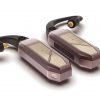These days, DVRs (Digital Video Recorders) are virtually everywhere. DVRs let you easily record your favorite shows, watch them whenever you want, and most even let you pause, slow down, and rewind live TV. With all the flexibility they offer, it’s no wonder DVRs are appearing in lots of cable boxes, and satellite receivers. With an ever growing number of options and expanding capabilities, this versatile technology can fit just about anyone’s budget and needs.
shows, DVRs let you pause live TV and
replay dramatic moments.
DVRs, also known as PVRs (Personal Video Recorders), team a vast hard drive with an on-screen program guide like TiVo, TV Guide On Screen, or one provided by your cable or satellite provider. This combination makes recording and accessing your shows quick and easy. Capturing single episodes or whole seasons of your favorite programming can happen at the touch of a button. Plus, many DVRs feature dual tuners, allowing you to watch one show while recording another. And since the DVR automatically finds empty space on the hard drive and gives you easy options for managing your recorded content, you don’t have to worry about accidentally recording over something.
HD-capable DVRs: Recording in high-definition
Many of today’s DVRs can also record high-definition programming. With an HD programming source, an HD-capable TV, and an HD DVR, you can record a show broadcast in HD, then watch it later in all its original, stunning detail.
Keep in mind though, if you transfer recorded material from your high-def DVR to DVD or VHS, the recording will be made in standard definition since these formats were not designed to support high-definition.
Choosing a DVR
Many people today get a DVR from their programming provider. The month-to-month rental price of a cable box with a DVR compared to one without is typically relatively small. Satellite providers include DVRs with some of their programming packages, or let you upgrade your satellite receiver to a DVR for a small monthly fee. Getting a DVR from your programming provider may not give you a whole lot of choices in which one you get, but if you do have options, here are some questions you may want to ask your cable or satellite company:
- What hard drive capacities do they offer? As a general rule of thumb, 1GB = approximately 15 minutes of recording time at the highest quality, or 1 hour of recording time at VHS quality. You want to make sure you don’t run out of space during the season finale of your favorite show.
- Do they offer an HD-capable DVR? As mentioned earlier, a high-def DVR let you watch and record HD programming without losing any picture detail. It’s essentially a must-have for a die-hard HD fan.
- What kind of outputs does their DVR have? Make sure the DVR fits in with the rest of your system. For example, you don’t want to get a DVR with a coaxial digital audio output when the only unused digital input on your receiver is optical. (See below for more information on connections.)
Multi-room DVRs
Like their name suggests, multi-room DVRs allow you to watch programs recorded on your DVR in multiple rooms in your house. For example, if you have a multi-room DVR in your living room, you can watch any of the shows saved on it in your bedroom or office. You can even watch two different shows in two different rooms. Or, pause the recording of a live program in one room, and resume watching and recording it in another. Verizon currently offers a multi-room DVR through their FiOS fiber optic TV service, and cable companies plan to release them sometime this year.
Each of the additional rooms requires a compatible set-top box, but not necessarily another multi-room DVR. Data is transmitted between boxes via standard coaxial cable (the same type of cable used to bring cable TV into your home). Contact your service provider for availability in your area, as well as information on the exact equipment you’ll need.
Getting connected
Whether you have a stand-alone DVR or one built into your cable box or satellite receiver, the connections are essentially the same.
Front-panel inputs allow easy access for archiving your recordings from an external VCR or digital camcorder.
Video

Connect your high-def
DVR with an HDMI cable
to get the best picture.
For video, you’ll want to use the highest quality connection your DVR and TV have in common in order to get the best picture. If you don’t have a high-definition DVR, any of the familiar analog connections will do, but component video delivers the best picture. See our article on common video interconnects for more information on component video and other analog connections.
If you have a high-def DVR, you can either go with component video or HDMI. The all-digital HDMI interface yields an excellent picture and also carries audio, letting you make a simple, one-cable connection between your DVR and TV. Plus, HDMI is backwards-compatible with the older digital video connection, DVI. For more information, read our article on the ins and outs of HDMI.
Audio
Of course, the picture is only half the experience — you’ll need to make an audio connection as well. If you’re connecting your DVR directly to your TV, regular stereo patch cables cables will do the trick. However, many programs today are broadcast in surround sound, particularly those in high-definition, so why not take advantage of it? Just connect your DVR to a home theater receiver via an optical or coaxial digital audio cable.
If your DVR doesn’t have a digital audio output, but you have a receiver with Dolby Pro Logic II or Dolby Pro Logic IIx decoding, you can also enjoy wraparound sound using stereo patch cables.

by Loren Barstow, Crutchfield.com. All rights reserved. (reprinted with permission, originally posted May 26, 2009)






























